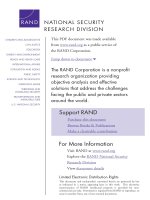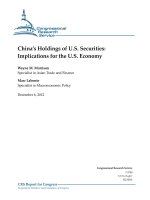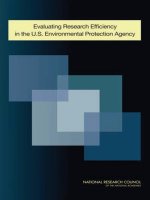Industrial biotechnology: development and adoption by the U.S, chemical and Biofuel industries
Bạn đang xem bản rút gọn của tài liệu. Xem và tải ngay bản đầy đủ của tài liệu tại đây (1.79 MB, 182 trang )
U.S. International Trade Commission
Address all communications to
Secretary to the Commission
United States International Trade Commission
Washington, DC 20436
COMMISSIONERS
Irving A. Williamson
Deanna Tanner Okun
Robert A. Rogowsky
Director of Operations
Karen Laney-Cummings
Director, Office of Industries
Charlotte R. Lane
Shara L . Aranoff, Chairman
Dean A. Pinkert
Daniel R. Pearson, Vice Chairman
U.S. International Trade Commission
Washington, DC 20436
Publication 4020 July 2008
www.usitc.gov
Industrial Biotechnology: Development
and Adoption by the U.S. Chemical
and Biofuel Industries
Investigation No. 332 481
This report was prepared principally by the Office of Industries
Project Leader
David Lundy
Deputy Project Leaders
Elizabeth Nesbitt and Laura Polly
Office of Industries
Laura Bloodgood, Jeffrey Clark, John Fry, Erland Herfindahl, Cathy Jabara,
Katherine Linton, Douglas Newman, John Reeder, Philip Stone, Karl Tsuji,
Jeremy Wise, and Isaac Wohl
Office of Economics
Robert Feinberg
Office of Investigations
Charles Yost
Primary Reviewers
Richard Brown and William Deese
Administrative Support
Brenda Carroll, Sharon Greenfield, and Monica Reed
Special Assistance
Wendy Cuesto, Brendan Lynch, Mark Paulson, Cynthia Payne, Joann Peterson,
Wanda Tolson, and Stephen Wanser
Office of Publishing
Under the direction of
Karen Laney-Cummings, Director, Office of Industries
Dennis Rapkins, Chief, Chemicals and Textiles
i
Abstract
This report was prepared in response to a request from the Committee on Finance of the
United States Senate regarding the competitive conditions affecting certain industries that
are developing and adopting new biotechnology processes and products. As requested by the
Committee, the report focused on firms in the U.S. chemical industry and U.S. producers of
liquid biofuels. Much of the data for this report was gathered by questionnaire directly from
the liquid fuel and chemical industries.
The development and adoption of industrial biotechnology (IB) in the United States by the
chemical and liquid fuel industries expanded substantially during the 2004–07 period. These
industries increasingly use enzymes, micro-organisms, and renewable resources in the
production of fuels and chemicals. IB has the potential to lower production costs, create
sustainable production processes, and reduce the environmental impact of producing and
using fuels and chemicals.
IB adoption is reflected in a large increase in sales of U.S produced liquid biofuels and bio-
based chemicals. Although a major portion of the increase is accounted for by the ethanol
and biodiesel industries, which are supported by government tax incentives, mandatory use
regulations, or both, pharmaceutical products still account for the majority of these sales.
Sales of liquid biofuels and bio-based chemicals remain small in comparison to conventional
chemicals and liquid fuels.
IB development may result in the creation of innovative products or processes. All measures
of innovation increased during the 2004–07 period, including R&D expenditures, patent and
trademark activity, strategic alliances, and government grants. However, operating income
as a share of total net sales of bio-based products was relatively flat during the period,
largely due to the substantial increase in agricultural feedstock prices. Feedstocks account
for over 50 percent of production costs for liquid biofuels.
Industry participants consider a lack of capital to be a major impediment to both the
development and adoption of IB. Many impediments identified by companies relate to the
risk inherent in new technology, including the uncertainty of whether such technologies can
be fully developed and adopted. This uncertainty makes it difficult to attract R&D and
investment capital. Other major impediments identified by liquid fuel and chemical
producers as affecting the adoption of IB include high feedstock and production costs and
limits of technology.
IB activities in many foreign countries also increased during the 2004–07 period. Like the
United States, foreign governments use tax incentives, mandatory use regulations, and R&D
funding to support their IB industries. Brazil, China, and the EU are notable examples.
iii
Abbreviations and Acronyms
ABARE Australian Bureau of Agricultural and Resource Economics
ACC American Chemistry Council
ADM Archer Daniels Midland
AMS Agricultural Marketing Service (USDA)
ANP Agência Nacional de Petroleo, Gas, e Biocombustieis (Brazil)
APTA Agência Paulista de Tecnologia dos Agronegócios (Brazil)
ARS Agricultural Research Service (USDA)
ASTRA Alliance for Science & Technology Research in America
BIO Biotechnology Industry Organization
Bio-PDO Bio-based 1,3 propanediol
BNDES Banco Nacional de Desenvolvimento Econômico e Social (Brazil)
BRDA Biomass Research and Development Act of 2000
BRDI Biomass Research and Development Initiative
CAP Common Agricultural Policy (EU)
CBERA Caribbean Basin Economic Recovery Act
CBP U.S. Customs and Border Protection
CCPA Canada’s Chemical Producers Association
CEBC Center for Environmentally Beneficial Catalysis
cpg Cents per gallon
CRAC China Resources Alcohol Co.
CRADA Cooperative Research and Development Agreement
CRFA Canadian Renewable Fuels Association
CRI Crown Research Institutions (New Zealand)
EC European Commission
ecoABC Agricultural Biofuels Capital Investment Program (Canada)
ECoAMu Energy Cogeneration from Agricultural and Municipal Wastes (Canada)
EERE Energy Efficiency and Renewable Energy (USDOE)
EESI Environmental and Energy Study Institute
EIA Energy Information Administration (USDOE)
EISA Energy Independence and Security Act of 2007
EPA U.S. Environmental Protection Agency
EPAct Energy Policy Act (of 1992, 2005)
ESAB European Federation of Biotechnology, Section on Applied Biocatalysts
ETBE Ethyl tertiary butyl ether
EU European Union
EuropaBio European Association of Bioindustries
FAME Fatty acid methyl ester
FAPRI Food and Agricultural Policy Research Institute
FLC Federal Laboratory Consortium
FSA Farm Service Agency (USDA)
FTC Federal Trade Commission
FTC Federal Transfer Consortium
FTE Full-time equivalent
FY Fiscal year
GBEP Global Bioenergy Partnership
GDP Gross domestic product
GHG Greenhouse gas
GLBSRP Great Lakes Biomass State-Regional Partnership
iv
GM Genetically modified
HTS Harmonized Tariff Schedule of the United States
IB Industrial biotechnology
IP Intellectual property
IPO Initial public offering
LCA Life-cycle assessment
MAPA Ministério de Agricultura, Pecuaria, e Abastecimento (Brazil)
MDA Ministério do Desenvolvimento Agrário (Brazil)
MF Ministério de Fazenda (Brazil)
mgy million gallons per year
MME Ministério di Minas y Energia (Brazil)
MTBE Methyl tertiary butyl ether
NAICS North American Industry Classification System
NAS National Academy of Sciences
NBB National Biodiesel Board
NCGA National Corn Growers Association
NREL National Renewable Energy Laboratory
NSB National Science Board
NTR Normal trade relations
NVCA National Venture Capital Association
ODC Other duties and charges
OECD Organization for Economic Cooperation and Development
ORNL Oak Ridge National Laboratory
PCT Patent Cooperation Treaty
PHA Polyhydroxyalkanoate
PLA Polylactic acid
PNPB National Program for Production and Use of Biodiesel (Brazil)
PTC Production-linked tax credits
PWC PriceWaterhouseCoopers
R&D Research and development
RD&C Research, development, and commercialization
RFA Renewable Fuels Association
RFS Renewable Fuel Standard
RPS Renewable Portfolio Standards
SBIR Small Business Innovative Research Program
SG&A Selling, general, and administrative
STDC Sustainable Development Technology Canada
STTR Small Business Technology Transfer Program
3-HPA 3-hydroxypropionic acid
UNCTAD United Nations Conference on Trade and Development
USDA U.S. Department of Agriculture
USDOE U.S. Department of Energy
USITC U.S. International Trade Commission
USPC U.S. Patent Classification System
USPTO U.S. Patent and Trademark Office
VAT Value-added tax
VC Venture capital
VEETC Volumetric ethanol excise tax credit
WTO World Trade Organization
v
Glossary
Biobutanol—Butanol is an alcohol that can be used as a replacement for gasoline.
Biobutanol, like ethanol, is produced either from conventional crops, such as corn, or from
cellulosic feedstocks. Some advantages that butanol has over ethanol as a transportation fuel
are a higher energy density, which provides more miles traveled per gallon of fuel, and a
lower tendency to absorb water, which provides more flexibility for transporting butanol and
blending it with gasoline. A current disadvantage of butanol versus ethanol is that it is more
expensive to produce using existing technology, making it less competitive with ethanol.
Biocatalysis—Biocatalysis is the use of isolated enzymes and/or micro-organisms as
biocatalysts to conduct chemical reactions.
Biocatalyst—According to the American Heritage Dictionary, a biocatalyst is “A substance,
especially an enzyme, that initiates or modifies the rate of a chemical reaction[, often] in a
living body.” Micro-organisms, including bacteria and fungi (e.g., yeasts), can also be used
as biocatalysts.
Biodiesel—A liquid biofuel suitable as a diesel fuel substitute or diesel fuel additive or
extender. Biodiesel is typically made from oils (e.g., soybean, rapeseed, or sunflower) or
from animal fats. Biodiesel can also be made from hydrocarbons derived from agricultural
products such as rice hulls.
Biofuels—Liquid fuels and blending components produced from biomass (plant) feedstocks,
used primarily for transportation. (PCAST, The Energy Imperative Technology and the Role
of Emerging Companies, November 2006, Glossary.)
Biomass—“Any organic matter that is available on a renewable or recurring basis, including
agricultural crops and trees, wood and wood wastes and residues, plants (including aquatic
plants), grasses, residues, fibers, and animal wastes, municipal wastes, and other waste
materials.” (Biomass Research and Development Act of 2000 7 USC 7624 Note.)
Biopolymers—A polymer comprised, at least in part, of building blocks called monomers,
produced in a biorefinery from renewable feedstocks such as corn. An alternate definition
for biopolymer, including all biologically produced polymers like DNA, RNA, and proteins,
will not be used in this study.
Biorefineries—“A biorefinery is a facility that integrates biomass conversion processes and
equipment to produce fuels, power, and chemicals. The biorefinery concept is analogous to
today’s petroleum refineries, which produce multiple fuels and products from petroleum.”
(National Renewable Energy Laboratory, Biomass Research.
/>.)
vi
Biotechnology—The use of enzymes and metabolic processes of living organisms (often
micro-organisms) to produce chemicals that have medical, environmental, or economic
value. “‘Biotechnology is the integrated application of natural and engineering sciences for
the technological use of living organisms, cells, parts thereof and molecular analogues for
the production of goods and services.’ Biotechnology thus consists of the use of living
organisms or parts thereof, to make or modify products, improve plants and animals, or
develop micro-organisms for specific purposes.” (European Federation of Biotechnology
(EFB) as noted in “Industrial Biotechnology and Sustainable Chemistry,” January 2004,
Royal Belgian Academy Council of Applied Science, 8.
/>.)
Building block chemicals—Chemicals that are subsequently converted to other chemical
products, either using methods of biotechnology or traditional chemical synthesis.
Chemical platforms—The term “chemical platforms” refers to the technological processes
to convert biomass into biofuels (e.g., bioethanol), chemicals, and power. Also, defined as
chemicals that are extracted from the agricultural feedstock as the first step in the biorefining
processing. The biorefinery subsequently converts these chemicals to fuels and/or building
block chemicals, so the term is also used to refer to biomass conversion technologies. The
main platforms are the sugar platform and the thermochemical platform.
Sugar platform—Conversion technology to “biologically process sugars in
biorefineries to fuel ethanol or other building block chemicals.” In a sugar platform,
sugars are often extracted from crops, such as sugarcane and corn, or from any
cellulosic feedstock, and then converted to derivatives including bioethanol and
biobutanol.
Thermochemical platform—“Converting the solid biomass to a gaseous or liquid
fuel by heating it with limited oxygen prior to combustion,” in turn allowing for the
conversion of the biomass to chemicals and other products. In a thermochemical
platform, bio-based synthesis gas produced from the partial combustion of biomass
contains hydrogen gas and carbon monoxide, among other gases, which can be
converted at high temperatures to a great variety of organic chemicals.
Enzymes—Biologically-derived, biodegradable proteins that speed up chemical reactions.
For example, in a biorefinery producing cellulosic ethanol and other chemicals, a group of
enzymes called cellulases is needed to breakdown cellulose into sugars that can be fermented
to produce the desired products.
Ethanol (also called bioethanol)—A clear, colorless, flammable, oxygenated hydrocarbon
(CH3-CH2OH). In addition to its uses as a chemical, ethanol is also a liquid biofuel that can
be used as a substitute for or blended with gasoline. It is produced by fermenting sugars from
carbohydrates found in agricultural crops and cellulosic residues. In the United States, the
biofuel is produced mainly from corn. Cellulosic ethanol is produced from lignocellulose
feedstocks (cellulosic residues), including agricultural residues (e.g., corn stover), forestry
residues (e.g., wood chips), energy crops (e.g., switchgrass), and municipal waste. It is also
used in the United States as a gasoline octane enhancer and oxygenate (blended up to
10 percent concentration; also called E10). Ethanol can also be used in high concentrations
(E85; a blend of 85 percent ethanol with 15 percent gasoline) in vehicles designed for its use,
which are usually called flex-fuel vehicles.
vii
Fermentation—The use of micro-organisms to break down complex organic compounds
into simpler ones.
Flex-fuel vehicle—A vehicle that can operate on:
(1) alternative fuels (such as E85),
(2) 100 percent petroleum-based fuels, or
(3) any mixture of an alternative fuel (or fuels) and a petroleum-based fuel.
Flex-fuel vehicles have a single fuel system to handle alternative and petroleum-based fuels.
Flex-fuel vehicle and variable fuel vehicle are synonymous terms. (PCAST, The Energy
Imperative Technology and the Role of Emerging Companies, November 2006, Glossary.)
Green chemistry—The design of chemical processes and products with the goal of reducing
or eliminating the consumption or generation of hazardous or toxic substances. This
commitment to developing alternative chemical syntheses reduces a company’s
environmental footprint and can improve a company’s competitiveness. Among the 12
principles of green chemistry are several that can be met through the use of industrial
biotechnology, including the prevention of waste, the design of safer and less toxic processes
and chemicals, a focus on increased energy efficiency, and incorporation of renewable
resources as inputs.
Greenhouse gas (GHG)—Those gases, such as water vapor, carbon dioxide, nitrous oxide,
methane, hydrofluorocarbons (HFCs), perfluorocarbons (PFCs), and sulfur hexafluoride, that
are transparent to solar (short-wave) radiation but opaque to long-wave (infrared) radiation,
thus preventing long-wave radiant energy from leaving Earth’s atmosphere. The net effect
is a trapping of absorbed radiation and a tendency to warm the planet’s surface. (PCAST,
The Energy Imperative Technology and the Role of Emerging Companies, November 2006,
Glossary.)
Industrial biotechnology (or white biotechnology)—Distinct from medical (red
biotechnology) and agricultural biotechnology (green biotechnology), industrial
biotechnology “is the application of modern biotechnology for the industrial production of
chemical substances and bioenergy, using living cells and their enzymes, resulting in
inherently clean processes with minimum waste generation and energy use.” (Royal Belgian
Academy Council of Applied Science, “Industrial Biotechnology and Sustainable
Chemistry,” January 2004, 10.
/>.)
The Commission’s definition of industrial biotechnology is: the manufacture of liquid fuels
and chemical products using enzymes, micro-organisms, fermentation, or biocatalysis at any
stage of production, regardless of the type of raw materials used (e.g., biomass, fossil fuel-
based, or inorganic substances), or the manufacture of liquid fuels and chemical products
from renewable resources regardless of the type of processing technology used.
Patent—A set of exclusive rights granted by a government to an inventor or his assignee for
a fixed period of time (usually 20 years) in exchange for the public disclosure of an
invention.
Trademark—A word, name, symbol, or device that is used in trade with goods to indicate
the source of the goods and to distinguish them from the goods of others.
viii
Trade secrets—Information that derives economic value from not being generally known
by others, and that is the subject of reasonable efforts to maintain its secrecy.
Transesterification—The reaction of an ester with an alcohol that results in the formation
of a different ester. In the production of biodiesel, the transesterification reaction removes
the fatty acid portions of the plant oils from their glycerin backbones to form fatty acid
methyl esters and the glycerin byproduct.
Venture capital—Money provided by professional investment firms that invest alongside
management in young, rapidly growing companies that have the potential to develop into
significant economic contributors. Venture capital is an important source of equity for
start-up companies.
Whole-cell systems—Micro-organisms that contain/generate multiple enzymes that perform
a series, or a “cascade,” of chemical conversions.
ix
CONTENTS
Page
Abstract i
Abbreviations and Acronyms iii
Glossary v
Executive Summary xv
Chapter 1. Introduction 1-1
Purpose 1-2
Scope 1-3
Processes and products 1-4
Industry coverage 1-5
Approach 1-5
Information collection 1-5
Analysis 1-6
Respondent profile 1-6
Report organization 1-9
Chapter 2. Trends in Bio-based Business Activities 2-1
Industry characterization 2-2
Liquid biofuels 2-2
Bio-based chemicals 2-7
Trade 2-10
U.S. imports 2-11
U.S. exports 2-14
Financial performance 2-15
Feedstock costs 2-15
Results of operations 2-16
R&D expenditures and employment 2-20
Government funding 2-23
Investment 2-25
x
CONTENTS–Continued
Page
Chapter 3. Factors Affecting the Development and
Adoption of Industrial Biotechnology
3-1
Cost and availability of feedstocks 3-3
Availability of capital 3-7
Capital-related impediments 3-11
R&D and innovation 3-11
Cellulosic ethanol 3-11
Other technologies 3-12
R&D impediments 3-17
Strategic alliances 3-18
Domestic supply chain and technology transfer alliances 3-19
Foreign supply chain and technology transfer alliances 3-24
Intellectual property 3-27
Patenting 3-30
Trademarks 3-34
Licensing and purchases and sales 3-34
IP-related impediments 3-35
Chapter 4. U.S. and Foreign Government Policies and
Programs 4-1
Research, development, and commercialization support 4-16
United States 4-16
Foreign country comparison 4-21
Tax incentives 4-22
United States 4-22
Foreign country comparison 4-28
Mandatory use regulations 4-30
United States 4-30
Foreign country comparison 4-32
Loan guarantees 4-33
United States 4-34
Foreign country comparison 4-35
Agricultural feedstock programs 4-36
United States 4-36
Foreign country comparison 4-42
Bibliography Bibl-1
xi
CONTENTS–Continued
Page
Appendices
A. Request letter from the Senate Finance Committee A-1
B. Federal Register notice B-1
C. Liquid biofuel and bio-based chemical industry activity in the United States
and selected countries C-1
D. Process advantages of bio-based products versus their conventional counterparts D-1
Boxes
1-1. Current issues regarding industrial biotechnology 1-2
2-1. The globalization of supply chains 2-11
2-2. U.S. tariff treatment for ethanol 2-13
2-3. Examples of recent industrial biotechnology merger and acquisition activity 2-28
3-1. U.S. agricultural feedstocks 3-3
3-2. Examples of domestic supply chain strategic alliances 3-21
3-3. Examples of domestic technology transfer alliances 3-22
3-4. Example of U.S foreign technology transfer strategic alliance 3-25
3-5. Examples of U.S foreign supply chain strategic alliances 3-26
Tables
1-1. Liquid fuels and chemicals: Respondents’ production and research and development
establishments, 2004–07 1-7
1-2. Industrial biotechnology: Respondent profile 1-8
1-3. Industrial biotechnology: Respondents’ indication of reasons for evaluating or
pursuing industrial biotechnology development or adoption 1-9
2-1. Liquid biofuel and bio-based chemical industries: Respondents’ U.S. activity trends,
2004–07 2-1
2-2. Liquid fuels: Respondent U.S. producers’ structure, sales, and employment, 2004–07 2-3
2-3. Ethanol: Respondent U.S. producers’ structure and shipments, 2004–07 2-4
2-4. Biodiesel: Respondent U.S. producers’ structure and shipments, 2004–07 2-6
2-5. Chemicals: Respondent U.S. producers’ structure, 2004–07 2-8
2-6. Chemicals: Respondent U.S. producers’ sales, shipments, and employment, 2004–07 2-9
2-7. Trade: Respondent U.S. producers’ U.S. exports and imports, 2004–07 2-12
2-8. Ethanol: Production costs and related data, 2002 and estimate as of March 2008 2-15
2-9. Biodiesel (virgin): Production costs and related data, 2006–08 2-16
2-10. Liquid fuels: Selected financial data for respondents’ operations, 2004–07 2-17
2-11. Chemicals: Selected financial data for respondents’ operations, 2004–07 2-19
2-12. Research and development: Respondents’ U.S. expenditures and employment, 2004–07 . . 2-21
2-13. Research and development: Respondents’ U.S. expenditures and employment for
their bio-based activities, by company groups, 2004–07 2-22
2-14. Government grants: Respondents’ receipts and matching funds, total and by selected
company groups, 2004–07 2-24
xii
CONTENTS–Continued
Page
Tables–Continued
2-15. Investment: Respondents’ U.S. expenditures, 2004–07 2-26
2-16. Investment: Respondents’ U.S. expenditures for bio-based activities, by company
groups, 2004–07 2-26
3-1. Industrial biotechnology adoption: Respondents’ indication of the significance of
commercialization impediments 3-2
3-2. Liquid biofuel and bio-based chemical companies: Respondents’ indication of
most important competitive factors affecting ability to market products 3-2
3-3. Agricultural feedstocks: Respondents’ ranking of issues affecting their
operations 3-4
3-4. U.S. prices of agricultural feedstocks, biofuels, and petroleum products, 2004–07,
and December 2007 3-5
3-5. Investment: Respondents’ indication of funding importance 3-9
3-6. Selected cellulosic ethanol pilot and demonstration plants 3-13
3-7. Examples of innovative industrial biotechnology 3-14
3-8. Industrial biotechnology development: Research and development impediment
significance, ranked by respondents 3-17
3-9. Research and development decisions by respondents: All companies and selected
company groups 3-18
3-10. Strategic alliances: Respondents’ reasons 3-19
3-11. Domestic strategic alliances: Number formed by respondents, 2004–07 3-20
3-12. National Renewable Energy Laboratory biomass program technology transfer
activities, 2003–07 3-24
3-13. Foreign strategic alliances: Number formed by respondents, 2004–07 3-25
3-14. Intellectual property: Respondents’ activity, 2004–07 3-28
3-15. Intellectual property: Respondents’ patent applications and trademarks registered,
by company groups, 2004–07 3-28
3-16. Intellectual property: Respondents’ income and costs, by company groups, 2004–07 3-29
3-17. Patents: Number granted to respondents, 1997–2007 3-29
4-1. Government programs: Respondents’ indication of importance in supporting development
or adoption of industrial biotechnology 4-3
4-2. Government policies directly supporting development or adoption of industrial
biotechnology by the liquid fuel and chemical industries in the United States and
selected countries 4-5
4-3. U.S. Department of Energy expenditures for biomass and biorefinery systems
research and development, 2003–07 4-17
4-4. U.S. Department of Agriculture and U.S. Department of Energy: Biomass research
and development awards by type of project, and company matches, 2002–06 4-18
4-5. Small Business Innovative Research (SBIR) and Small Business Technology
Transfer (STTR) program grants, by state, 2000–2007 4-19
4-6. Comparison of U.S. and foreign tax incentives for industrial biotechnology 4-22
4-7. Major U.S. federal government biofuel tax incentives 4-23
4-8. U.S. state tax incentives for industrial biotechnology 4-25
xiii
CONTENTS–Continued
Page
Tables–Continued
4-9. Comparison of U.S. and foreign mandatory use regulations for blended fuels 4-30
4-10. U.S. Department of Agriculture and U.S. Department of Energy: 2008 biomass
research and development grants 4-40
C-1. Liquid biofuel and bio-based chemical industry activity, United States and selected
countries C-3
D-1. Results of life-cycle assessments for certain bio-based products and their petroleum-based
counterparts D-6
Figures
ES-1. Liquid biofuels and bio-based chemicals: Share of shipments, by industry, 2007 xvi
ES-2. Industrial biotechnology: U.S. business activity trends, 2004–07 xvi
ES-2. Industrial biotechnology: Innovation indicator trends, 2004–07 xvii
1-1. Industrial biotechnology: Location of establishments, 2007 1-7
2-1. Conventional and bio-based liquid fuels and chemicals: Relative sales of respondents’
U.S. produced products, 2007 2-2
2-2. Research and development: Respondents’ U.S. expenditures for their bio-based activities,
by company groups, 2004–07 2-22
2-3. Research and development: Respondents’ employment growth, 2004–07 2-23
2-4. Investment: Respondents’ U.S. expenditures for bio-based production facilities, by
company groups, 2004–07 2-27
2-5. Investment: Respondents’ U.S. expenditures for bio-based research and development
facilities, by company groups, 2004–07 2-27
3-1. Total venture capital investment in industrial biotechnology, 1995–2007 3-10
3-2. Venture capital investment in industrial biotechnology, 1995–2007 3-10
3-3. Industrial biotechnology-related patents granted, U.S. and foreign origin, cumulative,
1975–2006 3-32
3-4. Foreign-origin patents, by country, 2006 3-33
3-5. Domestic-origin patents, by state, 2006 3-33
xv
Executive Summary
The Committee on Finance of the United States Senate requested the Commission to
examine the competitive conditions affecting certain industries that are developing and
adopting new industrial biotechnology (IB) processes and products. IB was defined for
purposes of this study as the manufacture of liquid fuel and chemical products using
enzymes, micro-organisms, or renewable resources. The report focuses on U.S. liquid biofuel
producers and firms in the U.S. chemical industry. The application of IB can improve the
efficiency of the industries and lead to the development of new products. The report provides
an understanding of the current impact of IB on the U.S. economy.
Overview and Principal Findings
The U.S. liquid biofuel and bio-based chemical industries expanded significantly from 2004
through 2007, although the current impact of this growth on the U.S. economy is relatively
small. In terms of shipments, the liquid biofuel industry, composed of ethanol and biodiesel
producers, grew at a faster rate, but the bio-based chemical industry, composed of
pharmaceutical and other chemical producers, is larger (figure ES-1).
The liquid biofuel and chemical industries use IB in many products and processes, some of
which are well established and already commercialized to a significant extent and others that
are emerging. These products and processes, many of which are innovative, are subjects of
significant R&D. The Commission's investigation, based on a detailed survey of these firms,
found that business activities in IB—including the number of establishments, sales,
shipments, production, employment, R&D expenditures, and investment—are growing at
a rapid rate (figure ES-2). The magnitude of these activities, however, remains relatively
small compared with that of the conventional chemical and liquid fuel industries.
Government incentives and mandates are significant and have been vital to the growth and
development of many of the companies that rely on IB, particularly for the liquid biofuel
industry.
Innovation is important to the future competitiveness and productivity of U.S. firms.
Innovation indicators—including R&D expenditures, strategic alliances, and intellectual
property registrations—document substantial levels of activity focused on the development
and adoption of new IB products and processes (figure ES-3). R&D expenditures for IB
increased at three times the rate of conventional R&D spending. Large and increasing R&D
expenditures have focused on the development of new drugs, advanced enzymes and
micro-organisms, the use of nonfood feedstocks and the improvement of yields, and the
development of higher-value co-products. New investments in pilot plants are moving the
technology for cellulosic ethanol toward commercialization.
xvi
Bio-based
pharmaceuticals
51%
Biodiesel
3%
Ethanol
28%
Other bio-based
chemicals
18%
FIGURE ES-1
Liquid biofuels and bio-based chemicals: Share of shipments, by industry, 2007
Source: Compiled from data submitted in response to U.S. International Trade Commission questionnaire.
80
100
120
140
160
180
2004 2005 2006 2007
Index
Sales R&D expenditures
Number of establishments Number of production employees
Value added
`
Note.—Index year 2004 = 100
Source: Compiled from data submitted in response to U.S. International Trade Commission questionnaire.
FIGURE ES-2
Industrial biotechnology: U.S. business activity trends, 2004–07
xvii
Note.—Index year 2004 = 100
Source: Compiled from data submitted in response to U.S. International Trade Commission questionnaire.
50
150
250
350
450
550
650
2004 2005 2006 2007
Index
New trademarks registered State grants New patent applications
Domestic strategic alliances Foreign strategic alliances Federal grants
FIGURE ES-3
Industrial biotechnology: Innovation indicator trends, 2004–07
Strong growth in the number of domestic and foreign strategic alliances is enabling the
transfer of technology and knowledge across universities, firms, and governments, and
facilitating the globalization of supply chains. The formation of domestic and foreign
strategic alliances has grown from 532 new IB alliances in 2004 to 1,367 new alliances in
2007. Patent and trademark activity has intensified as firms seek to protect, commercialize,
and license their new discoveries and brands. Trademark registrations in particular have
shown strong growth, increasing from 197 new registrations in 2004 to 1,027 in 2007,
reflecting the increasing prominence of bio-based brands as the field moves from early
discoveries to the commercialization of innovative technologies and products.
Among the most significant impediments to the successful development and adoption of IB
by the U.S. liquid fuel and chemical industries are the rising cost of feedstocks and the
inability to attract sufficient investment. More than one-half of the production costs for
ethanol and 75 percent of the production costs for biodiesel are attributable to feedstocks;
consequently, feedstock cost and availability significantly impact firm operating income as
a share of total net sales. Retained earnings and debt are the most significant sources of
capital for IB firms; however, many small firms, including those focused exclusively on
R&D, have limited access to these sources. For these firms, and for others developing new
technologies, attracting funds or capital is a leading impediment. Funding from alternative
sources such as venture capital companies, strategic alliance partners, and federal
xviii
government programs is critical, but often difficult to obtain. Impediments to the
development and adoption of IB reportedly have resulted in a number of firms deciding not
to pursue IB activities or to abandon a specific IB project.
Government programs assist in overcoming some impediments, particularly with respect to
liquid biofuels. Policies that contribute to the development and adoption of IB include tax
incentives; mandatory use regulations; research, development, and commercialization
support; loan guarantees; and agricultural feedstock support programs. The liquid biofuel and
bio-based chemical industries rank federal tax incentives, mandatory use regulations for final
products, and state or local tax incentives as the most important U.S. government policies.
IB has the potential to benefit the U.S. economy by allowing for the substitution of liquid
biofuels for conventional liquid fuels, potentially reducing crude petroleum imports, and
stimulating the development of rural economies as a result of increased agricultural
feedstock consumption. At the industry level, IB can improve production efficiency in the
liquid biofuel and chemical industries, resulting in potential reductions in manufacturing
costs and capital expenditures. The impact of IB on the productivity and competitiveness of
U.S. chemical and liquid biofuel firms is primarily related to the development of innovative
products and technologies. Life-cycle assessments conducted by firms to compare production
factors for bio-based products with their conventionally produced counterparts indicate that
IB can streamline production processes, lower energy consumption, and decrease waste
generation. IB can also create new products such as biodegradable plastics that can compete
with conventional products. IB may also provide a range of environmental benefits,
including sustainable production, reduced greenhouse gas (GHG) emissions, and less waste
generation.
Certain benefits of IB are controversial, especially concerning liquid biofuels. Questions
raised in this context include, but are not limited to, how corn used for ethanol affects food
supplies and prices, whether the increased production of corn is environmentally sustainable,
the magnitude of the impact of biofuels on GHG emissions, and the net energy content of
ethanol. An assessment of these factors is beyond the scope of this report. Whether the
promise of liquid biofuels and bio-based chemicals ultimately outweighs the potential
drawbacks will depend in large part on whether technological advances, such as cellulosic
ethanol, effectively mitigate some of the costs and other concerns, and on the impact of
government policy and market forces on the development of IB industries.
Liquid Biofuels
Because growth in the U.S. liquid biofuel industry during the 2004–07 period is primarily
the result of mandatory use regulations and tax incentives, it is difficult to assess the impact
of IB on the competitiveness and productivity of liquid biofuel firms. However, current R&D
efforts by U.S. firms on innovative technologies may enhance competitiveness and
productivity in the future. These technologies include, for example, the development of
cellulosic ethanol, which uses nonfood, and potentially less costly, feedstocks; and an
alternate liquid biofuel, biobutanol, which may offer increased energy content and greater
compatibility with existing liquid fuel distribution infrastructure and vehicle engines as
compared with ethanol.
xix
The number of liquid biofuel producers, production establishments, and the value of corn
ethanol shipments each more than doubled from 2004 through 2007. The value of biodiesel
shipments increased by almost 2,500 percent. U.S. imports and exports of liquid biofuels
increased significantly, with ethanol accounting for most activity. Operating income as a
share of total net sales remained relatively flat for liquid biofuel producers, largely due to
rising feedstock costs.
The levels of R&D activity and investment in IB increased strongly from 2004 through 2007,
both in absolute terms and compared with total liquid fuel industry R&D activity and
investment. Liquid biofuel R&D expenditures increased by more than 400 percent from 2004
through 2007, reaching $152.5 million. These expenditures increasingly focused on the
commercialization of cellulosic ethanol. Cellulosic ethanol technologies have been an
important focus of R&D and investment as firms seek to broaden the base of feedstocks.
Several companies are expected to bring pilot or demonstration plants onstream in the United
States in 2008, with one firm expected to begin commercial scale cellulosic ethanol
production. Liquid biofuel producers, as compared with bio-based chemical producers,
accounted for the majority of investment in production facilities.
The prices of the primary feedstocks used in U.S. liquid biofuels (corn for ethanol and
soybeans for biodiesel) increased during the past several years. Other feedstock-related
issues such as poor crop yields, storage capacity, supply disruptions, transportation
bottlenecks, feedstock quality, and the unavailability of new feedstock varieties were also
reported by liquid biofuel producers as impediments to the successful development and
adoption of IB. Government programs that support the supply and utilization of feedstocks
are particularly important to liquid biofuel producers. Federal programs affecting agricultural
feedstocks involve a wide range of activities, including direct support for farmers, R&D
projects at universities and in the private sector, and research at government laboratories.
Targeted U.S. and foreign government support for the development and adoption of IB is
much more extensive for the liquid fuel industry than for the chemical industry and is largely
driven by concerns about energy costs and security. Tax incentives are the most important
form of support for U.S. liquid biofuel producers, and are available at the federal and state
level. However, some firms report that current policies support a select few traditional
technologies for producing biofuels from traditional feedstocks, claiming that such policies
discourage innovation and the introduction of new biofuels to the marketplace.
Mandatory use regulations in the United States, ranked by liquid biofuel producers as the
second most important type of program, are comprehensive, with annually rising minimum
requirements for renewable fuels in the nation’s fuel supply. The strong growth of the U.S.
ethanol industry is largely attributable to U.S. mandatory use regulations.
The foreign countries examined in this report use tax incentives and have adopted or are
moving toward adoption of mandatory use regulations for liquid biofuels. All governments
also provide research, development, and sometimes commercialization support to the private
sector and fund government research entities that share findings with the private sector to
some degree. As in the United States, foreign government funding for liquid biofuels is
typically explicitly earmarked.
xx
Bio-based Chemicals
The bio-based chemical industry also expanded during the 2004–07 period, reflecting its
continued utilization of IB and its increasing commitment to green chemistry. Government
support policies do not target this industry to the extent they do the liquid biofuel industry.
The industry is also much less reliant on agricultural feedstocks. The pharmaceutical sector
dominates this industry. This sector is increasing its production of bio-based drugs, reflecting
the biological nature of producing consumer drugs such as vaccines and antibiotics, and its
increasing use of evolving bioprocesses. This industry also produces a wide variety of other
bio-based chemicals, such as commodity chemicals, food ingredients, and biodegradable
plastics.
The impact of IB on the competitiveness and productivity of bio-based chemical firms is
evident at the production and market levels through enhanced performance characteristics,
reductions in the environmental impact of production processes, reduction in production
costs and capital expenditures, the creation of innovative products, and novel market
positioning. Biopolymers, for example, produced sustainably from renewable resources such
as corn, are becoming increasingly competitive with their petrochemical counterparts in
terms of performance, cost, and product characteristics such as biodegradability.
Pharmaceutical companies are increasingly using IB to improve product purity and yield,
generate products that might otherwise not be technically feasible, incorporate sustainable
chemical processes, and realize related cost benefits. For example, the use of IB in the
production of certain antibiotics—a product category described as being highly competitive
with low margins—resulted in lower production costs and improved competitiveness.
The rate at which the bio-based chemical industry expanded, as expressed in the number of
producers, establishments, shipments, and employment, was less pronounced than that of the
liquid biofuel industry. Imports of bio-based chemicals declined slightly, while exports
increased by 17 percent during the period. Operating income as a share of total net sales
remained relatively flat for bio-based chemical producers.
The levels of R&D activity and investment in IB increased strongly from 2004 through 2007,
both in absolute terms and compared with total chemical industry R&D activity and
investment. R&D expenditures related to bio-based chemicals were much larger than those
related to liquid biofuels, reaching $3.4 billion in 2007. A small number of large
pharmaceutical companies accounted for a large share of bio-based chemical R&D
expenditures. Of the bio-based investment, pharmaceutical companies accounted for the
majority of investment in R&D facilities. The research focus is diverse in bio-based
chemicals, but largely targets the development of newer and more effective enzymes,
bio-based products, and production processes. Bio-based chemical producers and dedicated
R&D companies have been the largest contributors to the growth in technology transfer
alliances, entering into technology development alliances with foreign R&D firms and
universities.
Less government funding went to bio-based chemical producers than to liquid biofuel
producers, although bio-based chemical funding rose slightly during the period. As in the
United States, foreign government funding available to bio-based chemical producers is
usually part of more general authorizations.
1-1
CHAPTER 1
Introduction
Industrial biotechnology (IB) activities in the United States by the chemical and liquid fuel
industries increased substantially during the 2004–07 period. Sales of U.S produced bio-
based products, for example, increased by over 30 percent during the period. Much of this
growth is accounted for by the ethanol and biodiesel industries, which are strongly supported
by government tax incentives or mandatory use regulations, or both. Pharmaceuticals
accounted for the majority of IB sales. Sales of bio-based products remain small in
comparison to conventional chemicals and liquid fuels.
IB R&D activity in the United States also increased substantially during the 2004–07 period.
R&D expenditures rose by almost 72 percent; most of these expenditures were made by the
research-intensive pharmaceutical industry. Both intellectual property activity and strategic
alliances, which are focused on many innovative aspects of IB including noncrop feedstocks,
enzymes and micro-organisms, and production processes, grew during the period as well.
Government grants support many IB R&D activities.
Despite strong growth in some parts of these industries, U.S. firms identified several major
impediments to the development and adoption of IB. Most of these impediments relate to the
risk inherent with new technology, including the uncertainty as to whether such technologies
can be fully developed and adopted. This uncertainty makes it difficult to attract R&D and
investment funds. Other impediments affecting the adoption of IB include high production
costs, especially feedstock costs, and perceived high market risk in comparison to profit
potential.
IB activities in countries such as Brazil, China, and the EU also expanded during the
2004–07 period. As in the United States, governments of these countries use tax incentives,
mandatory use regulations, and R&D funding to support their IB industries.
The development and adoption of IB can benefit the U.S. economy in a number of ways,
such as allowing for the substitution of liquid biofuels for conventional liquid fuels, thereby
potentially reducing crude petroleum imports, and enhancing rural economies as a result of
increased agricultural feedstock consumption. At the industry level, IB can improve process
efficiency as compared with conventional processes, resulting in potential reductions in
manufacturing costs and capital expenditures. IB can also create new products such as
biodegradable plastics that compete with conventional products.
IB may have environmental benefits, including sustainable production, reduced greenhouse
gas (GHG) emissions, and less waste generation, particularly in regard to the production of
bio-based chemicals. However, certain apparent advantages of IB are currently subject to
conflicting points of view (box 1-1).









